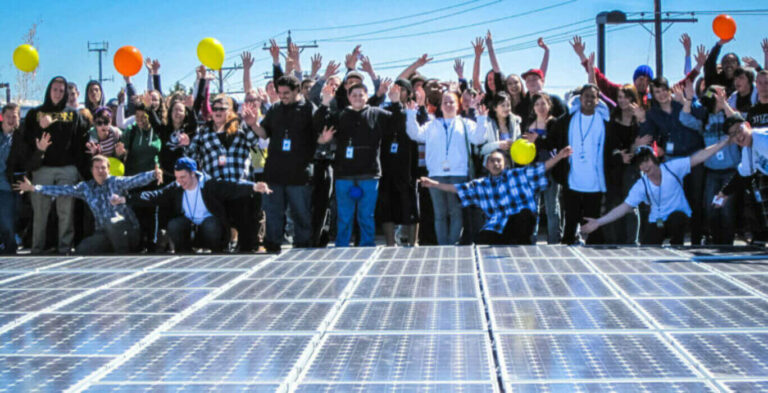Clean Technology (CleanTech): Meaning, Importance & The Future

CleanTech or clean technology refers to any measure taken to reduce or eliminate negative environmental impacts from technology.
CleanTech deals with pollution reduction, lower emissions, lower power consumption, and many other types of innovations that aim to save the planet from the negative effects of technology.
This blog post looks at CleanTech and what it might hold for your future and that of your business.
What Is CleanTech?
Clean technology, often referred to as CleanTech, is a broad discipline that encompasses various innovations and solutions to the energy and environmental problems of the planet. CleanTech promotes a cleaner and healthier planet for present and future generations.
CleanTech spans many technologies that include emissions cuts, reduction in natural resource consumption, the pursuit of environmental improvements, and an overall healthier planet for all.
The CleanTech Industry & Statistics
Driven in part by government incentives, increasing environmental awareness, and technological innovations, the CleanTech sector is experiencing steady growth. This development is additionally supported by the declining costs of renewable energy devices, such as solar and wind power.
The global renewable energy market was valued at $1.2 trillion in 2023 and is expected to grow with a 17.2% CAGR from 2024 to 2030. This is in part, thanks to stringent regulations and the shift to cleaner fuels in many countries.
As of 2020, China leads in wind energy with a total installed capacity of 221 GW and is followed by the U.S. with a 96.4 GW capacity, and Germany with 59.3 GW, according to Grand View research.
The solar power segment of renewable energy sources accounted for the largest market share in 2023 with 30.95%. The hydro-power segment followed with a 16.65% share.
CleanTech is not solely about energy though, the innovations are making positive impacts in various industries, such as agriculture, transportation, waste management, transportation, manufacturing, and the Internet.
The Importance of CleanTech
CleanTech is important for humanity and the planet because it offers many solutions to the problems of traditional, pollutant-heavy technologies. Here are some of the many advantages that may be achieved by adopting CleanTech practices.
- Public Health Benefits: Air and water pollution are two of the major negative effects of technology. Fossil fuel combustion and some industrial processes release gases and chemicals into the environment that can negatively affect the public’s health. Finding ways to develop technology and innovate, while keeping environmental pollution low, will go a long way in creating a healthier future for all.
- Climate Change: Although the issue of global warming can be quite debatable, it still remains in everyone’s interest to control environmental emissions and prevent extreme weather occurrences by following CleanTech practices.
- Energy Security: The world has proven global reserves of less than 50 times its annual consumption, meaning that crude oil will probably not last beyond the 2060s at the current global consumption. So, the world needs to secure energy for its industries, computers, and machines.
- Preserve Biodiversity: The preservation of biodiversity is another importance of CleanTech. This implies the protection of species and the conservation of ecosystems that are otherwise destroyed by technology through mining, emissions, and dumping of harmful waste.
- Preserve Natural Resources: By conserving energy, recycling materials, and using renewable energy, a lot of the earth’s natural resources can be conserved for the future.
- Create Economic Opportunities: CleanTech jobs create employment opportunities for those who want to pursue a just cause to do good while engaging in necessary economic activities.
Applications of CleanTech
The CleanTech field is vast and growing rapidly. It includes a wide range of innovations aimed at reducing the environmental impact of technology and thereby helps to build a more sustainable future. Here are some of these various applications.
- Renewable Energy: Different renewable energy forms can be monitored and optimized for maximum power production. Such systems require a synergy of hardware and software development to achieve results.
- Energy Efficiency: From smart homes to energy-efficient industrial buildings, data centers, and utilities, energy management hardware and software systems can find applications in vast areas using IoTs, sensors, and analytics to discover ways to optimize energy consumption patterns.
- Circular Economy: Computer systems now handle waste management systems, such as automated sorting facilities. Online auctions and shopping communities also make it easier to trade used goods, thereby reducing overall material waste. Plus, computer-aided circular product design is helping to reduce waste.
- Data Centers With Renewable Energy: Big companies like Amazon are developing huge data centers that are mostly powered by renewable energy. According to this page, 90% of the electricity consumed by Amazon in 2022 was attributable to renewable energy.
- Energy Efficient Networking: From low-power routers and networking equipment to the edge computing approach that processes user input in data centers nearest to the user, CleanTech is equally present in networking.
- Green IoT & Smart Grids: The Internet of Things (IoT) is another important aspect of CleanTech. They enable smart grids to monitor and optimize energy distribution and consumption, thereby reducing waste and improving overall energy efficiency.
- Cloud Computing: Cloud environments merge the activities of multiple servers into a single platform, thereby reducing their overall energy consumption and further optimizing processes using dynamic resource allocation, energy-aware scheduling, and other innovative energy-saving approaches.
- BIPVs: Building-integrated photo Voltaics are silicon (photovoltaic) materials that are used to replace conventional building materials in areas such as roofs, skylights, and facades. BIPVs serve a double purpose in buildings by providing both physical protection and generating electricity at the same time. The style and productivity of a BIPV will determine its market success.
- Smart Agriculture: From hydroponics to modern greenhouses with IoT environment control, the application of CleanTech methods can enable the production of better-quality food with minimal input.
Challenges
The CleanTech movement also has its challenges. Here are some of the major ones.
- Intermittent Renewable Energy: Coal is cheap and reliable, unlike the intermittent energy sources of solar and wind. This situation cements the industrial use of coal for many decades to come, as the renewable energy industry tries to find solutions to the intermittency problem of solar and wind power.
- Policy Uncertainty: Another hurdle to CleanTech development is inconsistent or unclear policies from the government. By lacking long-term, clear-cut policies and regulatory authorities to make sure such policies are implemented, many jurisdictions fail to attract CleanTech-related businesses and investments.
- Financing Issues: Investing in CleanTech can be less attractive from a financial viewpoint, because the projects usually take longer to be profitable, and they are often not the most financially profitable too.
- Storage Technology: A large part of CleanTech initiatives depend on energy storage technologies, especially the battery that makes it possible to store the energy generated from intermittent sources like solar and wind power. However, current battery technologies are still limited in capacity and lifespan, as well as hampered by high costs.
- High Initial Costs: Many CleanTech innovations require high initial costs to develop and implement. Secondly, as these innovations are usually meant to replace already existent, yet, wasteful technology, the payoff for making such investments into CleanTech is often considered too little.
Future Outlook
The future of CleanTech is promising as concerns about climate change and environmental degradation continue to grow. You can expect to see more advancements in clean energy technologies, energy storage systems, sustainable transportation, and circular economy practices in the future.
The improvements and innovations will make renewable energy sources such as solar, wind, and hydro-power even more cost-effective, while smart grids, intelligent energy management systems, IoT-enabled devices, and more energy-efficient computing systems will enhance overall energy efficiency.
Circular economy principles will probably gain more traction too, as more people realize the benefits of CleanTech for the planet and all in it. This should lead to even more overall improvements.
Innovations in energy storage technologies, however, remain the last hurdle to achieving a truly clean technological future, as batteries still need better efficiencies and lower prices.
How You Can Help
If you are concerned about the environment and would like to contribute in one way or the other to a healthier planet, then here are some of the ways that you can help.
- Reduce your energy consumption where possible.
- Invest in renewable energy sources wherever you can.
- Opt for sustainable products and services.
- Advocate for policies that support CleanTech development.
- Educate your family and friends about CleanTech and its importance.
- Support businesses and organizations that operate with CleanTech.
Resources
- https://www.cleantech.com/
- https://www.worldometers.info/oil/
- https://www.grandviewresearch.com/industry-analysis/renewable-energy-market
- https://www.irena.org/
- https://link.springer.com/article/10.1007/s10586-022-03713-0
- https://www.pv-magazine.com/2023/12/01/battery-prices-down-14-this-year-says-bloombergnef/
- https://www.linkedin.com/pulse/global-ev-battery-cell-prices-fall-below-100kwh-danilo-onorino-zhy1e
- https://sustainability.aboutamazon.com/products-services/the-cloud
- https://docs.kernel.org/scheduler/sched-energy.html
- https://kubernetes.io/docs/concepts/scheduling-eviction/dynamic-resource-allocation/
- https://cleantechnica.com/
- https://www.cebn.org/
- https://www.digitalclimate.io/
Conclusion
Rounding off this post on CleanTech and the future, you have seen the different tech sectors involved in the industry and how they interact. You must have also noticed that this is about more than just technology – CleanTech is a mindset, a movement.
CleanTech is leading the journey towards a sustainable future. But as the planet belongs to us all, so too must everyone join hands to collectively innovate and build a greener, more prosperous future for all.





